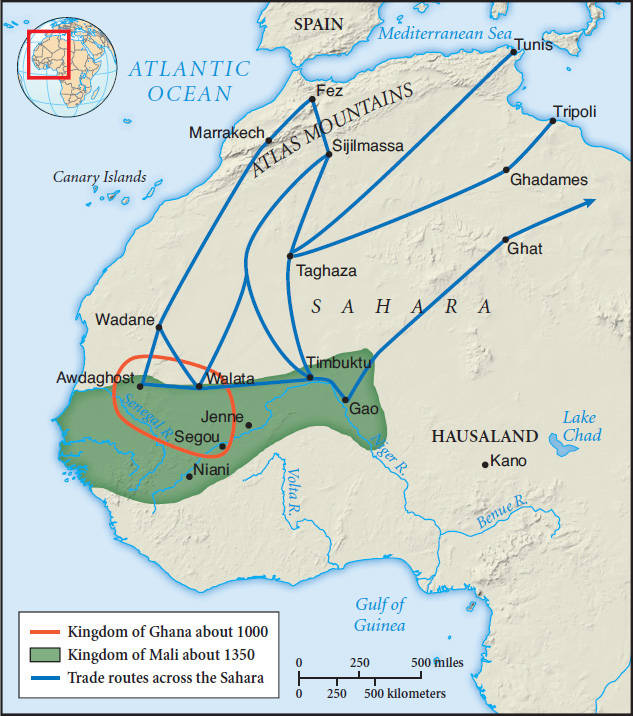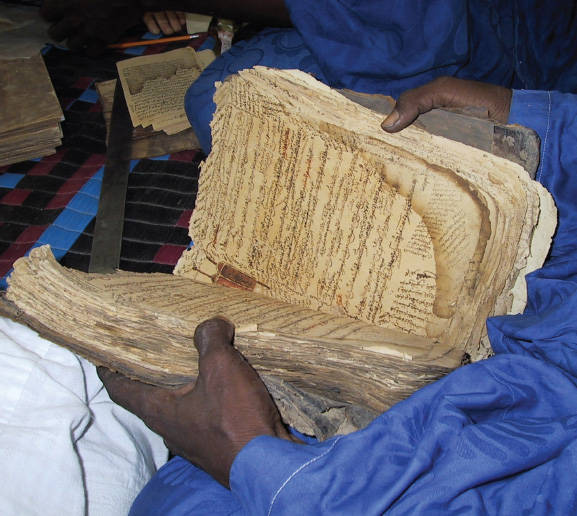Gold, Salt, and Slaves: Trade and Empire in West Africa
Connection
Question
What changes did trans-Saharan trade bring to West Africa?
[Answer Question]
A major turning point in African commercial life occurred with the introduction of the camel to North Africa and the Sahara in the early centuries of the Common Era. This remarkable animal, which could go for ten days without water, finally made possible the long trek across the Sahara. It was camel-owning dwellers of desert oases who initiated regular trans-Saharan commerce by 300 to 400 C.E. Several centuries later, North African Arabs, now bearing the new religion of Islam, also organized caravans across the desert.
What they sought, above all else, was gold, which was found in some abundance in the border areas straddling the grasslands and the forests of West Africa. From its source, it was transported by donkey to transshipment points on the southern edge of the Sahara and then transferred to camels for the long journey north across the desert. African ivory, kola nuts, and slaves were likewise in considerable demand in the desert, the Mediterranean basin, and beyond. In return, the peoples of the Sudan received horses, cloth, dates, various manufactured goods, and especially salt from the rich deposits in the Sahara.
Thus the Sahara was no longer simply a barrier to commerce and cross-cultural interaction; it quickly became a major international trade route that fostered new relationships among distant peoples. The caravans that made the desert crossing could be huge, with as many as 5,000 camels and hundreds of people. Traveling mostly at night to avoid the daytime heat, the journey might take up to seventy days, covering fifteen to twenty-five miles per day. For well over 1,000 years, such caravans traversed the desert, linking the interior of West Africa with lands and people far to the north.
As in Southeast Asia and East Africa, this long-distance trade across the Sahara provided both incentives and resources for the construction of new and larger political structures. It was the peoples of the western and central Sudan, living between the forests and the desert, who were in the best position to take advantage of these new opportunities. Between roughly 500 and 1600, they constructed a series of states, empires, and city-states that reached from the Atlantic coast to Lake Chad, including Ghana, Mali, Songhay, Kanem, and the city-states of the Hausa people (see Map 7.4). All of them were monarchies with elaborate court life and varying degrees of administrative complexity and military forces at their disposal. All drew on the wealth of trans-Saharan trade, taxing the merchants who conducted it. In the wider world, these states soon acquired a reputation for great riches. An Arab traveler in the tenth century C.E. described the ruler of Ghana as “the wealthiest king on the face of the earth because of his treasures and stocks of gold.”23 At its high point in the fourteenth century, Mali’s rulers monopolized the import of strategic goods such as horses and metals; levied duties on salt, copper, and other merchandise; and reserved large nuggets of gold for themselves while permitting the free export of gold dust.

This growing integration with the world of international commerce generated the social complexity and hierarchy characteristic of all civilizations. Royal families and elite classes, mercantile and artisan groups, military and religious officials, free peasants and slaves—all of these were represented in this emerging West African civilization. So too were gender hierarchies, although without the rigidity of more established Eurasian civilizations. Rulers, merchants, and public officials were almost always male, and by 1200 earlier matrilineal descent patterns had been largely replaced by those tracing descent through the male line. Male bards, the repositories for their communities’ history, often viewed powerful women as dangerous, not to be trusted, and a seductive distraction for men. But ordinary women were central to agricultural production and weaving; royal women played important political roles in many places; and oral traditions and mythologies frequently portrayed a complementary rather than hierarchal relationship between the sexes. According to a recent scholar:
Men [in West African civilization] derive their power and authority by releasing and accumulating nyama [a pervasive vital power] through acts of transforming one thing into another—making a living animal dead in hunting, making a lump of metal into a fine bracelet at the smithy. Women derive their power from similar acts of transformation—turning clay into pots or turning the bodily fluids of sex into a baby.24
Certainly the famous Muslim traveler, Ibn Battuta, visiting Mali in the fourteenth century, was surprised, and appalled, at the casual intimacy of unmarried men and women. (See Document 7.3.)

As in all civilizations, slavery found a place in West Africa. Early on, most slaves had been women, working as domestic servants and concubines. As West African civilization crystallized, however, male slaves were put to work as state officials, porters, craftsmen, miners harvesting salt from desert deposits, and especially agricultural laborers producing for the royal granaries on large estates or plantations. Most came from non-Islamic and stateless societies farther south, which were raided during the dry season by cavalry-based forces of West African states, though some white slave women from the eastern Mediterranean also made an appearance in Mali. A song in honor of one eleventh-century ruler of Kanem boasted of his slave-raiding achievements.
The best you took (and sent home) as the first fruits of battle. The children crying on their mothers you snatched away from their mothers. You took the slave wife from a slave, and set them in lands far removed from one another.25
Most of these slaves were used within this emerging West African civilization, but a trade in slaves also developed across the Sahara. Between 1100 and 1400, perhaps 5,500 slaves per year made the perilous trek across the desert, where most were put to work in the homes of the wealthy in Islamic North Africa.
These states of Sudanic Africa developed substantial urban and commercial centers—such as Koumbi-Saleh, Jenne, Timbuktu, Gao, Gobir, and Kano—where traders congregated and goods were exchanged. Some of these cities also became centers of manufacturing, creating finely wrought beads, iron tools, or cotton textiles, some of which entered the circuits of commerce. Visitors described them as cosmopolitan places where court officials, artisans, scholars, students, and local and foreign merchants all rubbed elbows. As in East Africa, Islam accompanied trade and became an important element in the urban culture of West Africa. (See Document 7.3 and Chapter 9.) The growth of long-distance trade had stimulated the development of an African civilization, which was linked to the wider networks of exchange in the Eastern Hemisphere.